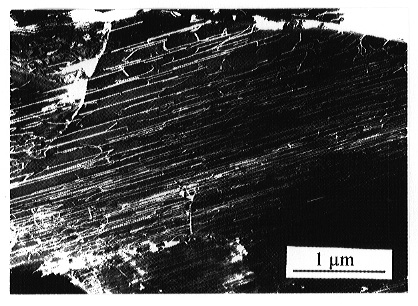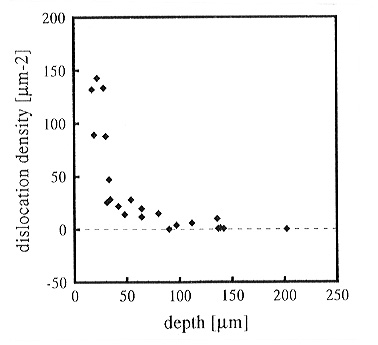

Shock experiments are indispensable to the understanding of the formation of dynamically produced (shock) defects in minerals. The use of ultra-short high-energy laser pulses is part of a new technique to produce shock defects at a much shorter time scale (nanosecond range) than conventional shock experiments such as gas guns or high-explosives (about 1 µs), or those found in nature (up to 1 s). Therefore, laser shock experiments are essential for determining the importance of time in the formation of shock defects.
Since previous attempts have so far failed to reproduce shock defects in quartz (Cordier et al. 1995, J. Mat. Sci. 30, 4009), olivine, the predominant phase in shocked ordinary chondrites, was selected for our experiments. Experiments have been carried out with a new setup at the Large Scale Facility LULI (Laboratoire pour l´Utilisation des Lasers Intenses, Ecole Polytechnique, Paris-Palaiseau, France), equipped with a Neodymium-glass laser. The laser beam was directed via mirrors and lenses onto the experimental set-up consisting of two Al foils and the specimen. The upper 18 µm thin Al foil acted as flyer plate and was spaced from the specimen by a 0.5 mm thin Al foil with a 3 mm wide hole. Laser beam diameter, pulse, and energy were 2 mm, 2.5 ns, and 80 J, respectively. These conditions resulted in a pressure of 55 GPa at the olivine surface. Due to the new sandwich set-up, ejection of sample material was prevented.
Subsequent TEM analysis of the fully recovered target area of olivine
revealed the presence of two important defects: (1) numerous dislocations
with Burgers vector [001] (Fig. 3.8-2) and (2) planar fractures with orientations
(031), (023), (041). Both defects are well known to occur in naturally-shocked
olivine. Dislocations are mainly of screw character but they can turn at
their tips to edge character. Glide planes are: (100), (010), and {110}.
Dislocation
 |
|
densities were found to be very high, up to 2 x 1014 m-2. As the shock wave rapidly decays with increasing depth, the dislocation density shows a similar tendency with a maximum decrease at 30 µm (Fig. 3.8-3). The fracture density decreases similarly with increasing depth. Numerical calculations of the variation of shock pressure as a function of depth are currently under way. The correlation between dislocation and fracture density and the concentration of dislocations on the fracture tips indicate that fracturing is the source of the dislocations. The dislocation velocity was calculated from the length of dislocations and the shock pulse. Dislocations were determined to have propagated at about 5 km/s, i.e. approximately sound velocity. These results demonstrate that laser experiments are not only capable of reproducing lattice defects in silicates but also help to gain insights into their formation kinetics.
 |
| Fig. 3.8-3: Dislocation density in shocked olivine as function of depth |

Tel: +49-(0) 921 55 3700 / 3766, Fax: +49-(0) 921 55 3769, E-mail: bayerisches.geoinstitut(at)uni-bayreuth.de
 Previous page
Previous page